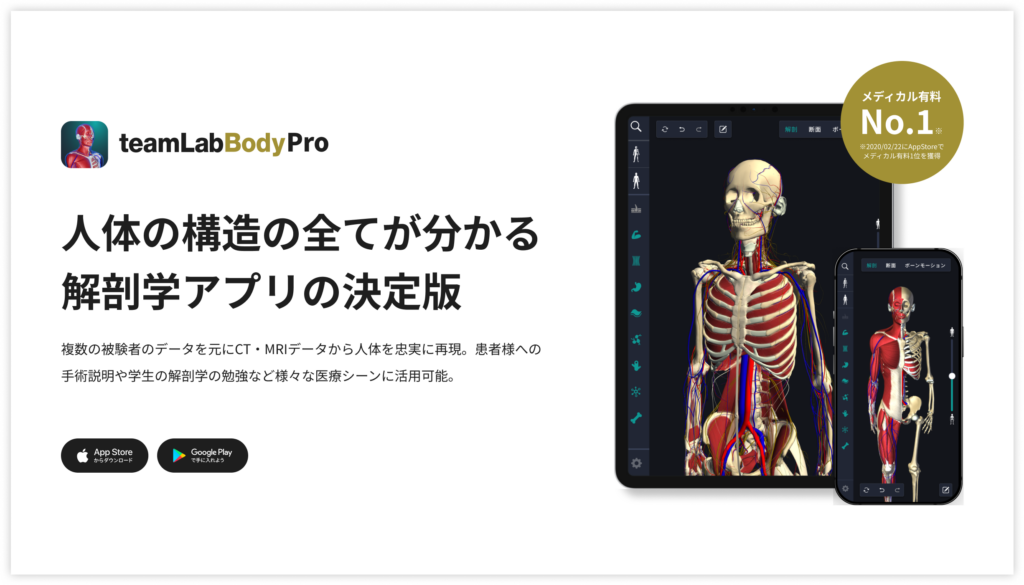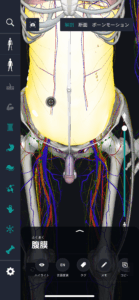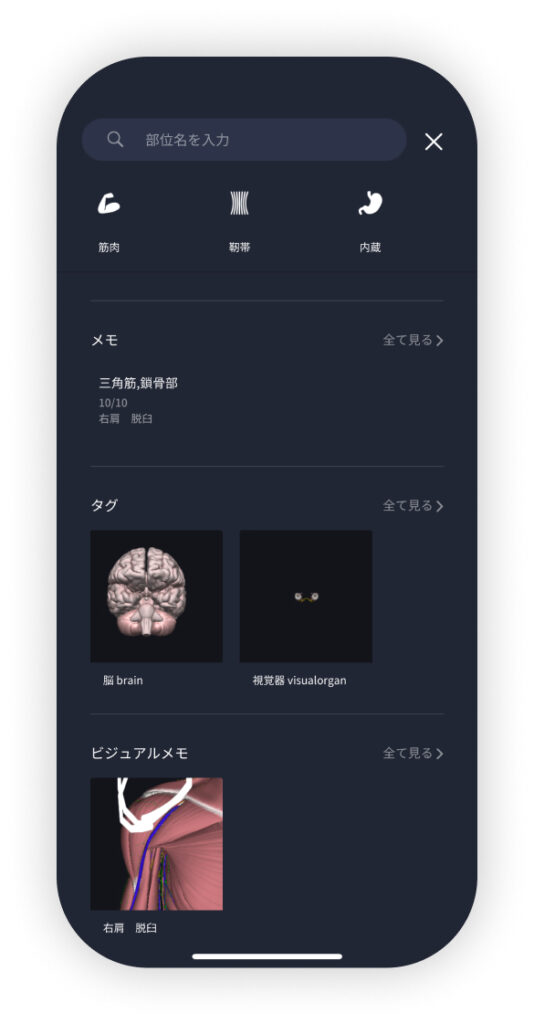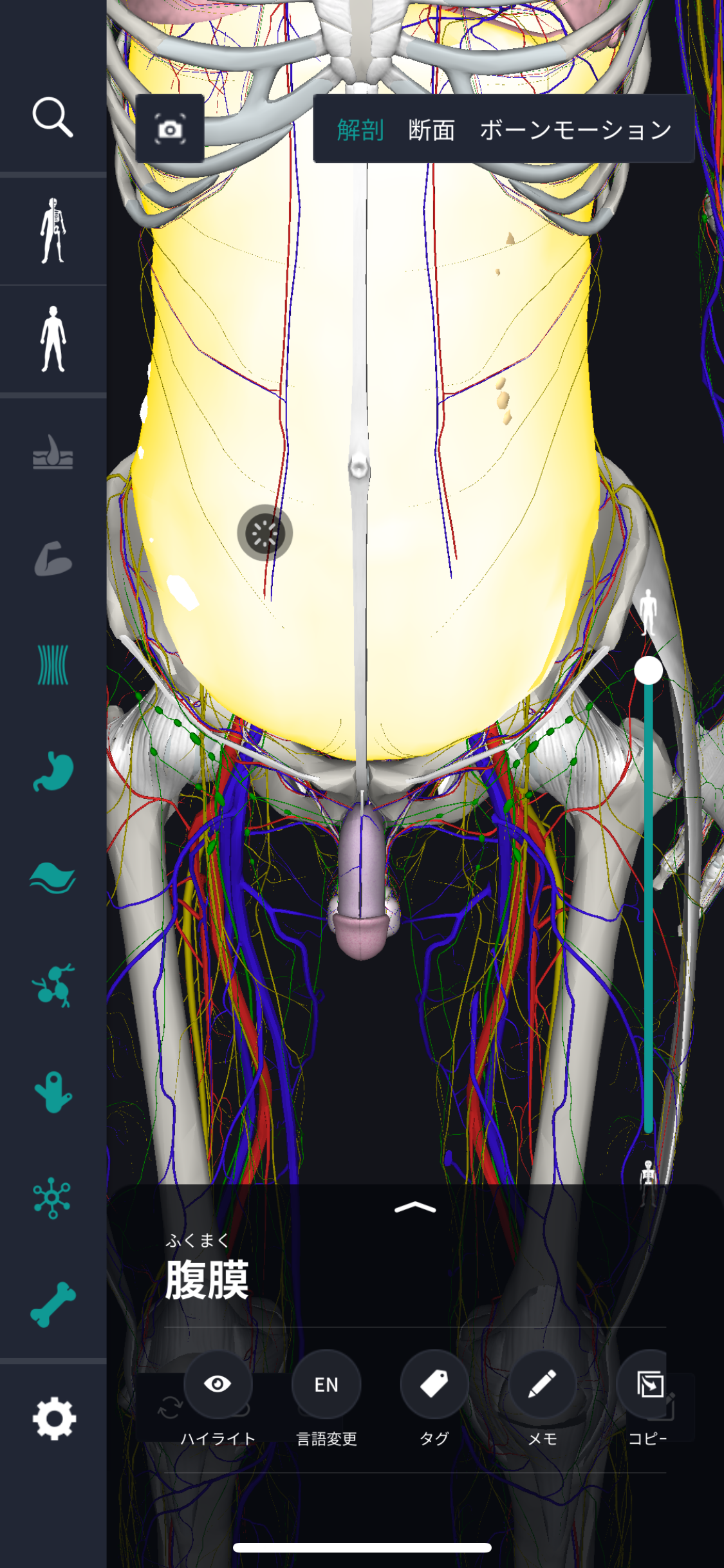beginning
In this article, I will explain effective study methods, starting with knowledge of specialized parts in human anatomy.
In human anatomy, it is necessary not only to memorize the names of various organs, muscles, and bones, but also to remember where they are located in the body. Therefore, it is necessary to learn as efficiently as possible.
I hope you can read this article and use the app to deepen your understanding even a little bit.
Now, I'll explain the details about the “peritoneum” and how to study human anatomy.
teamLab Body Pro Free Download
A 3D anatomy app that shows all the structures of the human body
Download teamLab Body Pro here!

What is peritoneum?
In the anatomy application, you can view a selection of anatomy 3D models. In this model, there are various observation methods such as surfaces, cross-sections, and nervous systems. This time, I'll explain using an anatomy application.
About peritoneum

Study points
Location and structure of the peritoneum
The peritoneum is a thin membrane that covers organs within the abdominal cavity, and forms a space called the peritoneal cavity. This membrane has two layers. One is parietal peritoneum, which covers the inner surface of the abdominal wall, diaphragm, and pelvic cavity, and is extremely sensitive to external stimuli. The other is the visceral peritoneum, which covers the surface of internal organs and is in close contact with internal organs, so sensitivity to irritation is low, but it closely wraps the organ. Between these layers, there is a peritoneal cavity containing lubricating fluid, and this fluid helps the organs move smoothly. Furthermore, while holding organs in place, the peritoneum plays many roles essential to digestive health, such as supplying nutrients, protecting against infection, and regulating body fluid movement. For example, the mesentery supports the small intestine while passing through blood vessels and nerves, and the mesentery has a role in suppressing and protecting inflammation. Thus, the structure and function of the peritoneum plays an important role in normal digestion and defense function of the human body.
The role and function of the peritoneum
The peritoneum not only physically protects the organs in the abdominal cavity, but also plays a variety of important roles. Its main roles and functions are explained as follows. First, the peritoneum stabilizes the position of organs and provides a smooth surface to prevent friction between organs. This minimizes friction that occurs when the digestive organs move, and helps the organs function smoothly. In particular, intestinal movement is important, and fluid in the peritoneal cavity, which helps lubrication, supports this. Furthermore, the peritoneum acts as a barrier to prevent infections. When inflammation or injury occurs in organs, the peritoneum mobilizes inflammatory substances and cells to localize the infection and play a role in stopping the spread. This function is particularly important in pathological conditions such as tumors and infections. In addition, the peritoneum also plays a role as part of the immune system. The peritoneum collects immune cells and enables an early inflammatory response to fight infection. In particular, it functions as a field that enables a rapid immune response against bacterial intrusion into the abdominal cavity. Also, the peritoneum is involved in the movement of nutrients and fluids. The reabsorption and supply of fluids here is essential for maintaining fluid balance, and a treatment known as peritoneal dialysis utilizes material exchange through membranes. In this way, the peritoneum performs a multifaceted function of physical support, infection protection, immune monitoring, and maintaining nutritional and fluid balance, and plays an extremely important role in maintaining physical health, mainly the digestive system.
English notation for peritoneum
The peritoneum is a thin membrane that covers the organs in the abdominal cavity and has many important functions. First, the peritoneum holds organs in place and stabilizes them. This allows the digestive tract and other internal organs to move freely, and it plays a role in smoothing that movement and preventing friction. There is lubricating fluid in the peritoneal cavity, which helps the organs move. The peritoneum also plays an important role in protecting against infection. When inflammation occurs in an organ, the peritoneum wraps around that area and prevents bacteria and foreign matter from spreading to other parts of the body. Controlling this local infection can help prevent systemic infections. In addition, the peritoneum also plays an active role in immune function. By triggering an inflammatory response, it forms a line of defense against foreign substances and pathogens. Immune cells located in the peritoneum support this process and enable a rapid biological response. Furthermore, the peritoneum is also involved in regulating fluid balance, and nutrients and water are exchanged. In particular, in treatments such as peritoneal dialysis, a process of removing waste products and excess water from the body via a membrane is used, which is useful for treating kidney failure, etc. Thus, the peritoneum has a wide range of roles and is extremely important in maintaining the health of the digestive system and overall body in terms of physical support, infection protection, immune response, and nutritional and fluid management.
How to study human anatomy
I will explain specific study methods using human anatomy applications.
Check your past learning history and practice repeatedly
Here are the steps to check your anatomy learning history and practice iteratively effectively.
1. Check your learning history in the app
Reviewing your learning history with the application is an important step in effectively advancing anatomy learning. First, launch the app and go to the learning history section from the main menu. Many anatomy apps are designed to show your progress in the form of graphs and lists, so you can visually check which parts you've learned about and how much time you've spent.
By using this data, you can understand which areas you have strengths in and where you need to spend more time and effort. We also recommend using a dedicated tag or notebook function to mark areas you are particularly weak at or where you need to relearn. Regularly checking your learning history and looking back on past learning content will lead to efficient review and deepening understanding.
2.Make a plan for iterative learning
Making an efficient repetitive learning plan based on learning history is extremely effective in promoting knowledge retention. First, identify weak points and areas where you need to relearn. Next, arrange these study items into a weekly or monthly calendar and create a specific study schedule. By proceeding in a planned manner, you can learn each part evenly and avoid packing in a large amount of information at once.
Using a task management app or digital calendar to set study reminders is effective. Also, it's important to have the flexibility to regularly review progress and revise plans as needed. By having goals and proceeding with your studies in a planned manner, you can efficiently acquire anatomical knowledge.
3.Use 3D features to learn visually
By utilizing the 3D function, learning anatomy is easier to understand visually. The 3D model shows the structure of the human body three-dimensionally, and each part can be observed in detail. This makes it possible to intuitively grasp positional relationships between deep muscles and organs that are difficult to capture in a planar view. For example, you can learn even the smallest details by rotating specific muscles and bones and zooming in and out.
Also, there are many apps that have the function of displaying cross-sectional views of each part using a 3D model, which is useful for deepening understanding of internal structures. This diversity of visual information helps with memory retention and improves immediate responsiveness in tests and practice situations. By utilizing the 3D function and learning visually, you can learn anatomy knowledge more deeply and efficiently.
Use the memo function concretely

Test your learning regularly in the form of quizzes
Regularly testing what you've learned in a quiz format is a very effective way to anchor your anatomy knowledge. Quiz-style tests help you objectively grasp your level of understanding and areas you lack while repeating knowledge.
For example, by using a learning app to conduct quizzes every specific period, you can reconfirm what you've learned and strengthen your memory. There are a wide range of quiz formats, such as multiple choice questions, fill-in-the-blank questions, and short answer questions, and each helps understanding from a different angle and develops the ability to utilize various types of knowledge.
Get feedback
If possible, get feedback from other learners and experts. It helps you find your own gaps in understanding and areas for improvement. You can also keep yourself motivated to learn by regularly testing yourself. Feeling a sense of accomplishment and progress increases motivation for continuous learning.
summary
This time, I explained how to study about the “peritoneum” using an application!
Thank you for reading this far.
I would be happy if reading this article helped you learn about anatomy.
Learning is a long, never-ending journey, but I sincerely wish you all the best. Let's continue to study together and work hard for the national exam!
Please look forward to the next blog.




